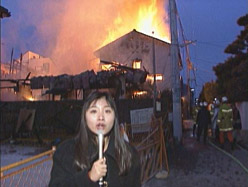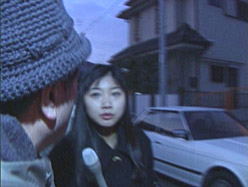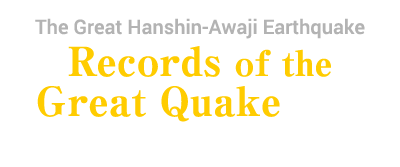Story Behind Releasing the Great Hanshin-Awaji Earthquake Video Footage Archive for Public Viewing
2020.1.10
Twenty-five years have passed since the Great Hanshin-Awaji Earthquake, which claimed the lives of more than 6,000 people. Today, nearly half of all Kobe residents have little or no knowledge of the disaster. The memories and the lessons learned are fading rapidly.
In connection with releasing archived footage from the earthquake, we asked university students who were born after the disaster to watch images taken at the time. Disasters happen every year. Although we expected these students to be used to this type of footage, we received many surprising comments.
“I have never seen a survivor talk so frankly in front of the camera.”
“I feel their determination to continue living, even while experiencing such indescribable sorrow.”
“I think we have much to learn today from the words and expressions of the survivors.”
What did people do and think in the face of an unexpected catastrophe, the collapse of their city and their lives? The students experienced something that isn’t being conveyed in disaster footage from more recent times.
The Great Hanshin-Awaji Earthquake was the first major earthquake in history where the fateful moment and the subsequent reconstruction process were recorded in detail on video. ABC retains an expansive library of archived footage from event and the aftermath.
We wish to share the lessons conveyed by these images for the benefit of future generations.
Therefore, the ABC Group has decided to release portions of our Great Hanshin-Awaji Earthquake Video Footage Archive to the public online. We hope that many will view these valuable images and use them as a basis for disaster prevention and mitigation in the future.
We also hope this initiative will encourage a worldwide movement to release archived video records of natural disasters to the public for sustainable use and application.
About the Archived Footage
We have released approximately 38 hours of footage in this project, taken from our coverage of the Great Hanshin-Awaji Earthquake over a period of about seven months, from the time immediately after the earthquake to August 23 in 1995. We are releasing this footage unedited to the greatest extent possible to communicate the unusual conditions surrounding a disaster.
The approximate locations of these video clips are shown on the map indicating the affected areas. We segregated the videos into the following 12 categories to allow search by date and scene.
Fire/House Collapse/Infrastructure/Rescue/Evacuation Shelters/Medical Care/Living/Education /Transportation/Recovery and Reconstruction/Self-Defense Forces, Police, Firefighters/Support and Volunteers/
We hope this video footage archive will be viewed widely by individuals, families, and schools for use in disaster prevention and mitigation. Your thoughts and opinions are highly appreciated. Please use the contact form on this website. We will use your feedback to improve this website and other future activities.
If any individual or entity wishes to use the footage archive images for other purposes as noted below, please contact us by filling out the information required in the form below:
- ・Use by corporations, local governments, and other organizations
- ・Screening at commercial events, etc.
- ・Lending footage archive images for other use
Use of footage archive images without prior notice and permission may be considered copyright infringement.
Thank you for your understanding and cooperation in connection with the release of this video footage archive.
Click here to share your thoughts, opinions and/or inquiries.The Public Release Process
1. Updating the visuals of disaster footage archives from 25 years ago for 2020 specifications
The words spoken by the survivors in these images contain many lessons that teach us about future disasters. We transcribed reports and interviews to give more visibility to the archived footage, ensuring that the generation of reporters who never learned of the disaster gain an understanding of the details and the situation on the ground without having to review every minute of the extensive footage available. We have also arranged the content to be accessed in a variety of ways.
ON: Reporter “It's 6:30 in the morning. The sky is beginning to lighten. A fire has broken out in a private home here, close to Ohara-cho, Ashiya City. The fire is believed to have been caused by short circuit. The fire is spreading to a neighboring home.”

ON: Man “I hope it doesn't burn down.”
ON: Reporter “But the water pressure isn’t nearly strong enough.”
ON: Man “No, it’s not enough. Even a layman can see that.”

2. Student Workshop: Images From the Great Hanshin-Awaji Earthquake as Seen by a New Generation
*Held on November 16, 2019 at our office.
University students who did not experience the Great Hanshin-Awaji Earthquake viewed the ABC TV video footage archives.
We asked the students to provide feedback that might present video footage from the disaster in a new light. Comments included responses to the following questions:
- 1. What surprised you most about the images? What types of images were not included in the TV broadcasts?
- 2. Did the images offer lessons for future generations? What lessons were offered?
- 3. In what ways do you think those images that offered value worth preserving will be viewed?
After watching the videos, the students provided numerous comments, including the following statements:
“I saw the devastation in the evacuation shelters in a way I never had.”
“It was enlightening to see the survivors talk frankly about what they lacked.”
“I could see clearly how the survivors stood strong in the face of a long recovery.”
3. Workshop: The Impact of the Archive and Issues to Overcome
*Held on December 6, 2019 at our office.
We invited research institutes and academic researchers (listed below) knowledgeable about disasters, video archives, portrait rights, etc., to the workshop.
The workshop addressed the delicate issue of portrait rights of disaster victims, the challenges faced by library archives of the Great East Japan Earthquake, and the challenges of preserving and releasing the disaster archives owned by the Disaster Reduction and Human Renovation Institution (DRI) in Kobe City. Attendees discussed more effective ways to use archives based on opinions and thoughts gathered via student workshops and through questionnaire results.
The researchers who contributed to the workshop:
- Ryoga Ishihara
- Associate Professor, Social Systems Engineering and Safety Systems, Faculty of Policy Science, Department of Policy Science, Ryukoku University
- Shosuke Sato
- Associate Professor, Information Society and Trust, International Research Institute of Disaster Science, Tohoku University
- Masahiro Sogabe
- Professor, Public Broadcasting, Public Law/Mission of the Media, Faculty of Law, Graduate School of Law, Kyoto University
- Norio Maki
- Professor, Disaster Prevention Research Institute, Kyoto University; Director of Earthquake Disaster Records Research, Disaster Reduction and Human Renovation Institution
- Hideaki Matsuyama
- Associate Professor, Image Archive Theory, Faculty of Sociology, Kansai University


